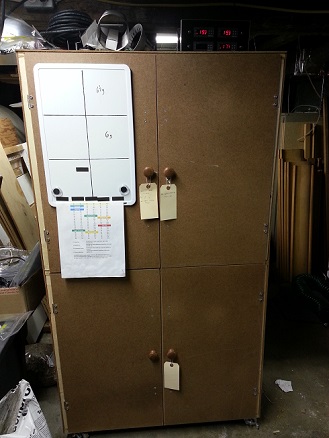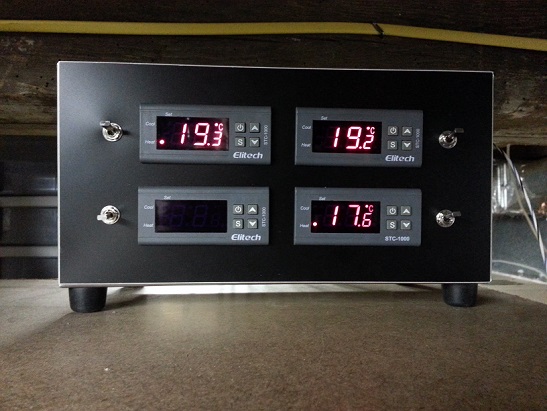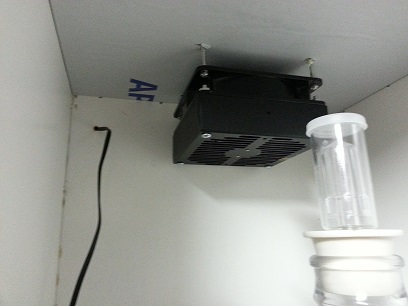I built a 4 compartment fermentation cabinet last year using the popular ST1000 controllers, 4" muffin fans and mating 'equipment heaters'. The wiring on the heaters and fans was setup so the fan and heater both come one at the same time. I knew this was not ideal as you can get major temperature variation from top to bottom, but was OK with it till I completed the housing for the controllers, and updated the fans to run at slow speed when the heat was off, and full speed when the heat was on.
I finally got the housing done to the point where I could mount the controllers properly, and get it wired up for this winters brewing season. During the summer/fall my basement is pretty stable in the mid 60's so no need for heating then.
I do not have the motor controls done yet, so I decided to just let the fans run full speed all the time, and have the heater cycle on and off. Got that wired up earlier tonight, and left it to settle for a couple hours. When I went and checked on it, all three active chambers were well above the set points, and rising with no heat on. As I stood there all 3 increased by .1C. Huh? Well it seems my chamber is so well insulated that the 24 watts the fans produce is enough to run the heat cycle!
I know there are a lot of people running various controllers, but has anyone found that you can get away with this little amount of heat to maintain the temps? My concern is that when the temp outside goes back to winter and my basement drops to around 50 the fans may not be enough and I'll need real heat, but that requires a re-wire again.
I'm still going to do the fan speed control (I'm building my own scr controllers) for 1 as soon as I can, and reconnect the heater to see if the lower power on the fan will give me the control I need with the 2 working together.
I've got extensive electronics and heating controller background, so I don't need any feedback on this part, but I'd love to hear from anyone that's encountered any similar issues with too much heat just from fans!
And the pics, cause everyone wants pics! The white board would normally have the brew specs on it, but since I just got them in the carboy tags are hanging on the knobs for now. The extra 2 spaces in the white board are for my lager cooler. The switches on the controller are to control heat/off/cool mode. Eventually I want to incorporate some amount of cooling for summer brews when I need it, as my plan to cool to lager temps in this cabinet has hit a snag, but that's another story.
John



I finally got the housing done to the point where I could mount the controllers properly, and get it wired up for this winters brewing season. During the summer/fall my basement is pretty stable in the mid 60's so no need for heating then.
I do not have the motor controls done yet, so I decided to just let the fans run full speed all the time, and have the heater cycle on and off. Got that wired up earlier tonight, and left it to settle for a couple hours. When I went and checked on it, all three active chambers were well above the set points, and rising with no heat on. As I stood there all 3 increased by .1C. Huh? Well it seems my chamber is so well insulated that the 24 watts the fans produce is enough to run the heat cycle!
I know there are a lot of people running various controllers, but has anyone found that you can get away with this little amount of heat to maintain the temps? My concern is that when the temp outside goes back to winter and my basement drops to around 50 the fans may not be enough and I'll need real heat, but that requires a re-wire again.
I'm still going to do the fan speed control (I'm building my own scr controllers) for 1 as soon as I can, and reconnect the heater to see if the lower power on the fan will give me the control I need with the 2 working together.
I've got extensive electronics and heating controller background, so I don't need any feedback on this part, but I'd love to hear from anyone that's encountered any similar issues with too much heat just from fans!
And the pics, cause everyone wants pics! The white board would normally have the brew specs on it, but since I just got them in the carboy tags are hanging on the knobs for now. The extra 2 spaces in the white board are for my lager cooler. The switches on the controller are to control heat/off/cool mode. Eventually I want to incorporate some amount of cooling for summer brews when I need it, as my plan to cool to lager temps in this cabinet has hit a snag, but that's another story.
John





